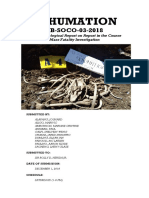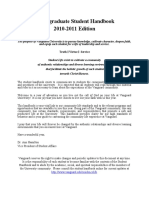Sherlock Holmes, The Adventure of Black Peter
Sherlock Holmes, The Adventure of Black Peter
Uploaded by
SHAHID AHMEDCopyright:
Available Formats
Sherlock Holmes, The Adventure of Black Peter
Sherlock Holmes, The Adventure of Black Peter
Uploaded by
SHAHID AHMEDOriginal Description:
Original Title
Copyright
Available Formats
Share this document
Did you find this document useful?
Is this content inappropriate?
Copyright:
Available Formats
Sherlock Holmes, The Adventure of Black Peter
Sherlock Holmes, The Adventure of Black Peter
Uploaded by
SHAHID AHMEDCopyright:
Available Formats
Locard’s exchange principle
Locard’s exchange principle is an important part of forensic science investigation. It
states that any criminal leaves behind a trace when committing a violent crime. It is the
investigator’s duty to find this trace evidence and reconstruct the events of the crime.
As long as the criminal remains upon two legs so long must there be some indentation,
some abrasion, some trifling displacement which can be detected by the scientific
researcher.
~ Sherlock Holmes, The Adventure of Black Peter
Forensic science has changed the way crime investigations are handled. By examining
and analyzing the physical evidence and reconstructing the circumstances of the crime,
forensic investigators are able to come up with scientific information that they can
present in court. A person who is responsible for one of the most important principles in
forensic science is Edmond Locard. He came up with the Locard’s exchange principle
or Locard’s theory which states that “Any action of an individual, and obviously, the
violent action constituting the crime, cannot occur without leaving a trace.”
A devout viewer of crime investigative series on television will be able to understand the
importance of this principle. Haven’t we all observed how the investigator goes to the
site of a grisly murder and examines the crime scene, to check for blood stains,
footprints or fingerprints, murder weapons and even the slightest of traces of blood in
the nails? This is known as trace evidence, and according to Locard’s principle
whenever a crime is committed, trace evidence no matter how small or less, will always
be present.
Understanding Locard’s Exchange Principle
To understand Locard’s theory it is important to understand how important trace
evidence is to forensic investigation. When a crime is committed, the police and
investigators are left with fragmented pieces of a puzzle. The forensic team helps in
reconstructing the puzzle with the help of trace evidence which refers to evidence left
behind by the criminal on the crime scene. This can be anything from hair, fibers, pieces
of clothing, blood, fingerprints, etc.
According to noted forensic scientist Paul L. Kirk
“Wherever he steps, whatever he touches, whatever he leaves, even unconsciously, will
serve as a silent witness against him. Not only his fingerprints or his footprints, but his
hair, the fibers from his clothes, the glass he breaks, the tool mark he leaves, the paint
he scratches, the blood or semen he deposits or collects. All of these and more, bear
mute witness against him. This is evidence that does not forget. It is not confused by the
excitement of the moment. It is not absent because human witnesses are. It is factual
evidence. Physical evidence cannot be wrong, it cannot perjure itself, it cannot be
wholly absent. Only human failure to find it, study and understand it, can diminish its
value.”
Development of Locard’s Exchange Principle
Before the 19th century, most of the time in court and during investigation, witness
testimonies were favored as opposed to evidence. Most investigators refused to
perform invasive procedures on the dead body due to emotional respect,
squeamishness and sometimes even superstitions. With the progression of scientific
studies in anatomy and microscopy, science was integrated into criminal investigations.
The first known use of science and logic for crime investigation was done by Alphonse
Bertillon in the late 1800s.
He developed Bertillonage, a simple procedure which involved recording a series of
body measurements and noting other physical characteristics. This information was
then placed on a single identification card in a police file. Prior to the use of fingerprint
recognition, this was the most used system of tracking and identifying criminals.
Apart from body measurement, Bertillon was also responsible for development of
photography for criminal identification.
It was Bertillon’s contribution to the forensic sciences that influenced Dr. Edmond
Locard, the vanguard of forensic science. He was the director of the first crime
laboratory, in Lyon, France and worked as a medical examiner during World War I.
Like Alphonse Bertillon, Locard too advocated the use of scientific studies for criminal
investigation. According to him, “Il est impossible au malfaiteur d’agir avec l’intensité
que suppose l’action criminelle sans laisser des traces de son passage.” which
translates to “It is impossible for a criminal to act, especially considering the intensity of
a crime, without leaving traces of his presence.” He tested this principle of exchange
during many of his investigations.
In 1930, Locard published three papers in the American Journal of Police Science which
are now known as Locard’s Theory of Exchange
Other significant contributions by Locard involves dactylography, which is an area of
study that deals with fingerprints. He developed poroscopy, which is the study of
fingerprint pores and the impressions produced by these pores.
Application of Locard’s Exchange Principle
One of the best ways to demonstrate how Locard ‘s theory is applied, we take an
instance of an investigation done by Locard himself. In 1912, while investigating the
death of a Frenchwoman named Marie Latelle, the police questioned her boyfriend
Emile Gourbin. He claimed he was playing cards with his friends, and when questioned,
the friends attested to this fact. When the corpse was examined by Locard he found
evidence of death by strangulation.
He scraped underneath the boyfriend’s fingernails to look for skin cell samples. On
close examination under a microscope, Locard found a pink dust in the cell samples. He
figured this was makeup and although popular, makeup was not very widely
manufactured. After searching further he found a chemist who made custom-made
powder for the deceased woman and a match was made. With all evidence against him,
Gourbain confessed of murder and tricking his friends into believing his alibi.
Is it Possible to Get Away With “A Perfect Crime”
According to Locard’s “every contact leaves a trace” theory, it is impossible to commit a
crime without leaving behind fragmentary (or trace) evidence. It is the investigators job
to collect the physical evidence and carefully examine it, so as to create systematic
documentation. The documentation of the physical evidence along with the statements
of the witness, suspects, and victims help in crime reconstruction.
According to criminalist Dr. Richard Saferstein, The physical evidence left behind at the
crime scene plays a crucial role in reconstructing the events that took place surrounding
the crime. He further states that, the collection and documentation of physical evidence
is the foundation of a reconstruction.
The trace evidence can be divided into:
Physical (clothing, glass fragments, paint chips etc)
Biological (DNA, fingerpints, hair)
Natural evidence (soil, pollen, seeds and plants)
The Drawbacks of Locard’s Theory
One of the greatest drawbacks of Locard’s exchange theory lies in evidence dynamics.
This refers to the alteration of physical evidence before it has been examined by
investigators. There are many factors that can lead to the tampering and destruction of
evidence.
Staging (manipulation of objects in crime scene) by the offender
Secondary transfer of evidence
Actions of the victim before the crime
Witness actions
Natural factors like animal or insect activity, weather, decomposition.
Fire suppression efforts
Actions of police, scene technicians and medical personnel.
These factors can lead to the removal or obliteration of the evidence. They can often
mislead the investigators and cause problems with crime reconstruction.
Misinterpretations or misleading evidence can lead to inaccurate crime reconstruction.
To avoid this, the investigator needs to make sure that the crime scene investigation
and reconstruction is carried out with care.
You might also like
- G.R. No. 227070 - Adamson University Faculty and Employees Union v. Adamson UniversityDocument5 pagesG.R. No. 227070 - Adamson University Faculty and Employees Union v. Adamson UniversityJay jogs100% (2)
- Recent Advances in Forensic ScienceDocument11 pagesRecent Advances in Forensic ScienceHarshpreet SinghNo ratings yet
- Evidence Collection 6Document74 pagesEvidence Collection 6Derrick100% (1)
- Bio-Rad Crime Scene Student Pre-LabDocument5 pagesBio-Rad Crime Scene Student Pre-LabVictor YaoNo ratings yet
- Lesson 3footwear EvidenceDocument15 pagesLesson 3footwear Evidencesjha11870% (1)
- Branches of Forensic ScienceDocument9 pagesBranches of Forensic ScienceSriram ShirkeNo ratings yet
- Insect Evidence: Basic Collection Procedures at the Death SceneFrom EverandInsect Evidence: Basic Collection Procedures at the Death SceneNo ratings yet
- Crime Lab 101: 25 Different Experiments in Crime DetectionFrom EverandCrime Lab 101: 25 Different Experiments in Crime DetectionRating: 1 out of 5 stars1/5 (1)
- Crime Scenes: Revealing the Science Behind the EvidenceFrom EverandCrime Scenes: Revealing the Science Behind the EvidenceRating: 3.5 out of 5 stars3.5/5 (7)
- Quiz No 1Document8 pagesQuiz No 1LJ ValdezNo ratings yet
- LocardDocument2 pagesLocardhimanshi khivsaraNo ratings yet
- Collection of Biological Sample For Dna-Oct 9Document84 pagesCollection of Biological Sample For Dna-Oct 9Bea Samonte100% (1)
- Notes On Fundamental To Criminal InvestiDocument16 pagesNotes On Fundamental To Criminal InvestiGesler Pilvan SainNo ratings yet
- Final Special Crime Investigation With Legal Medicine ReviewDocument203 pagesFinal Special Crime Investigation With Legal Medicine ReviewRaquel IgnacioNo ratings yet
- Forensic Syllabus For Law StudentsDocument2 pagesForensic Syllabus For Law StudentsJoulyn KennyNo ratings yet
- 07 Crime Scene Doc & PhotogDocument46 pages07 Crime Scene Doc & PhotogMoussa ToudjaniNo ratings yet
- Fingerprint Forensics in Crime SceneDocument25 pagesFingerprint Forensics in Crime SceneJerico FloresNo ratings yet
- Fundamentals of Criminal Investigation: Sp03 Signabon A. Songday Chief, Inspectorate & Legal Affairs SectionDocument51 pagesFundamentals of Criminal Investigation: Sp03 Signabon A. Songday Chief, Inspectorate & Legal Affairs SectionLorene bbyNo ratings yet
- Autopsy ReportDocument2 pagesAutopsy Reportapi-277499662No ratings yet
- Forensic Chemistry: David CollinsDocument7 pagesForensic Chemistry: David CollinsAaron ChavezNo ratings yet
- Developing Latent Prints From Gloves PDFDocument3 pagesDeveloping Latent Prints From Gloves PDFmmmzimNo ratings yet
- ReconstructionDocument47 pagesReconstructionAl VincentNo ratings yet
- 1 Forensic or Legal MedicinDocument9 pages1 Forensic or Legal MedicinAzra AzmunaNo ratings yet
- Central Forensic Science LaboratoryDocument3 pagesCentral Forensic Science LaboratoryAKNo ratings yet
- Presumptive and Confirmatory Forensic TestsDocument16 pagesPresumptive and Confirmatory Forensic TestsJessicaHae100% (1)
- Csi Lesson Plan RevisedDocument4 pagesCsi Lesson Plan Revisedapi-333406454No ratings yet
- The Medicolegal Investigation of Deaths in CustodyDocument107 pagesThe Medicolegal Investigation of Deaths in CustodyEolia EffendiNo ratings yet
- Blood Spatter LectureDocument116 pagesBlood Spatter LectureSannie RemotinNo ratings yet
- Forensic Fiber Examination Guidelines PDFDocument59 pagesForensic Fiber Examination Guidelines PDFCielGaleraSiasoco100% (1)
- Homicide InvestigationDocument10 pagesHomicide InvestigationBALICLIC NOELA JANE PNo ratings yet
- Williamson Touch DNA ArticleDocument6 pagesWilliamson Touch DNA ArticleJohnJPowellNo ratings yet
- Why A Crime Scene Is The Important Focus of The InvestigationDocument7 pagesWhy A Crime Scene Is The Important Focus of The Investigationproctor957No ratings yet
- 4 - Lesson 2 - Worksheets-XxxDocument15 pages4 - Lesson 2 - Worksheets-Xxxhiteshcparmar100% (1)
- Forensic Studies Module 2 - Physical Evidence & The Legal SystemDocument50 pagesForensic Studies Module 2 - Physical Evidence & The Legal SystemMarkus WolfeNo ratings yet
- Forensic Medicine - From Old Problems To New ChallengesDocument394 pagesForensic Medicine - From Old Problems To New ChallengesIndera VyasNo ratings yet
- 11 Anthropology EntomologyDocument28 pages11 Anthropology EntomologyAdi AmarieiNo ratings yet
- Evidence Collection and Laboratory AnalysisDocument74 pagesEvidence Collection and Laboratory AnalysisCemal SanliNo ratings yet
- Collection and Preservation of Blood Evidence From Crime ScenesDocument17 pagesCollection and Preservation of Blood Evidence From Crime ScenesRoman Mamun100% (1)
- Investigacion de La Escena Del CrimenDocument236 pagesInvestigacion de La Escena Del CrimenelmolinosoccerNo ratings yet
- Crime Scene BasicsDocument10 pagesCrime Scene Basicsapi-233623316No ratings yet
- Forensic ExamDocument9 pagesForensic ExamManhal Hospital BosasoNo ratings yet
- CrimescenebasicsDocument7 pagesCrimescenebasicsapi-364549557No ratings yet
- EXHUMATION FileDocument41 pagesEXHUMATION FileJhai Jhai Dumsyy100% (1)
- Ethics in Forensic ScienceDocument10 pagesEthics in Forensic Scienceapi-218687995100% (1)
- Medico Legal AutopsyDocument5 pagesMedico Legal AutopsyIzny SyeeraNo ratings yet
- What Is Forensic ToxicologyDocument7 pagesWhat Is Forensic ToxicologyMurali G RaoNo ratings yet
- DecompositionDocument21 pagesDecompositionअनूप ठाकुरNo ratings yet
- Crime Scene InvestigationDocument11 pagesCrime Scene InvestigationPoppyannaNo ratings yet
- CriminalisticsjjDocument22 pagesCriminalisticsjjapi-3850952100% (2)
- Fingerprint Forensics in Crime Scene: A Computer Science ApproachDocument25 pagesFingerprint Forensics in Crime Scene: A Computer Science ApproachJerico FloresNo ratings yet
- CSI: Crime Scene Investigation: Resource GuideDocument54 pagesCSI: Crime Scene Investigation: Resource Guidecitizenschools100% (2)
- Physical EvidenceDocument30 pagesPhysical EvidenceVîšhwąkřmą HõńëÿNo ratings yet
- Collection and Preservation of Physical EvidenceDocument8 pagesCollection and Preservation of Physical EvidenceRoy David Gonzalez Angulo100% (1)
- HPLCDocument4 pagesHPLCLuis Siller AlmazanNo ratings yet
- Forensic ProjectDocument12 pagesForensic ProjectHiteshiSharmaNo ratings yet
- Violence Abuse & Sexual Assault: Prepared By:-Aadil Amin Class: - B.SC Nursing 3 Year Roll No: - 10Document16 pagesViolence Abuse & Sexual Assault: Prepared By:-Aadil Amin Class: - B.SC Nursing 3 Year Roll No: - 10Aadil AminNo ratings yet
- The Crime SceneeDocument41 pagesThe Crime SceneeGaurav GaurNo ratings yet
- 07-99001 RE Debra Milke March 14Document60 pages07-99001 RE Debra Milke March 14crimefileNo ratings yet
- 1000 Phrasal Verb in Context Páginas 10 17 Páginas 2 8Document7 pages1000 Phrasal Verb in Context Páginas 10 17 Páginas 2 8JoséNo ratings yet
- VocabularyDocument1 pageVocabularyVika EnglishteacherNo ratings yet
- Menyoo LogDocument1 pageMenyoo Logameenshykh03No ratings yet
- Eat BillyDocument28 pagesEat BillyblablaNo ratings yet
- Racism PresentationDocument11 pagesRacism Presentationapi-576503011No ratings yet
- S V A 1993 - 1 - SACR 600 - A - Eng TranslationDocument3 pagesS V A 1993 - 1 - SACR 600 - A - Eng Translationkutulloboitumelo08No ratings yet
- BailDocument6 pagesBailSheik AllaudinNo ratings yet
- People Vs EgagamaoDocument10 pagesPeople Vs EgagamaoJelaine AñidesNo ratings yet
- Case Study Among Records in Selected BarangayDocument28 pagesCase Study Among Records in Selected BarangayShannen Roz UrbiztondoNo ratings yet
- Criminal Law 2 SyllabusDocument18 pagesCriminal Law 2 SyllabusJenna Giron75% (4)
- Pre-Trial Brief (Kian Delos Santos)Document7 pagesPre-Trial Brief (Kian Delos Santos)Leslie Joy Pantorgo100% (1)
- G12 BLK6 Appert Group 2 UcspDocument11 pagesG12 BLK6 Appert Group 2 UcspBLOCK 9 SIAGONo ratings yet
- University of London La1010 ZB (265 0010) ZBDocument4 pagesUniversity of London La1010 ZB (265 0010) ZBholoNo ratings yet
- 18 - Crimes Against Humanity-text+Hand.Document4 pages18 - Crimes Against Humanity-text+Hand.cq86fs2wfgNo ratings yet
- Criminal Law Dissertation TopicsDocument4 pagesCriminal Law Dissertation TopicsPaySomeoneToWriteAPaperForMeUK100% (1)
- Criminal Report 2019 BDocument11 pagesCriminal Report 2019 BMalik Ahad AllahYar KhanNo ratings yet
- CIRAS Account Request ForDocument1 pageCIRAS Account Request ForPSSg Terence FerrerNo ratings yet
- Developmental/Multifactor/Integrated Theory (1930)Document5 pagesDevelopmental/Multifactor/Integrated Theory (1930)Adan HoodaNo ratings yet
- People of The Philippines v. George Gacusan: G.R. No FactsDocument2 pagesPeople of The Philippines v. George Gacusan: G.R. No FactsAnalyn Grace BasayNo ratings yet
- Tutorial 1 Criminal Law - 2021488276Document4 pagesTutorial 1 Criminal Law - 2021488276Nur Qistina Aisyah NazaroNo ratings yet
- Kapur Singh Vs State of Pepsu Case Summary (1956 S+Document3 pagesKapur Singh Vs State of Pepsu Case Summary (1956 S+raghavmayank886No ratings yet
- Twee - Mistery in The ZooDocument6 pagesTwee - Mistery in The ZooSvéd MátyásNo ratings yet
- Death in Mumbai - First Chapter - ExcerptDocument40 pagesDeath in Mumbai - First Chapter - ExcerptRandom House India100% (1)
- III. EssayDocument4 pagesIII. EssayCrisanto HernandezNo ratings yet
- Loyal White Knights of The Ku Klux KlanDocument12 pagesLoyal White Knights of The Ku Klux KlanCory Andrew HofstadNo ratings yet
- Criminal Law 2Document17 pagesCriminal Law 2Geralice GalangNo ratings yet
- People Vs GenosaDocument5 pagesPeople Vs GenosaRuss TuazonNo ratings yet
- Undergraduate Student Handbook 2010-2011 Edition: Truth Virtue ServiceDocument55 pagesUndergraduate Student Handbook 2010-2011 Edition: Truth Virtue ServiceGineton Alencar IINo ratings yet
- Transnational Insurgencyand Border Security Challengesin Lake Chad Basin The Nigerian PerspectiveDocument22 pagesTransnational Insurgencyand Border Security Challengesin Lake Chad Basin The Nigerian Perspectiveumar muhammadNo ratings yet

























































































